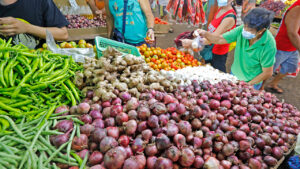The Future of Food: The benefits of farm-to-table, according to a farmer

PHILIPPINE STAR —WALTER BOLLOZOS
WHILE farm-to-table dining sounds like a call for sustainability or a cue for luxury, the path food takes from soil to plate uncovers many issues in the agricultural sector. Carlomagno Aguilar, co-founder and Chief Farmer and Head Farm Consultant at FarmYields, Inc. (also known as Carlo The Farmer on YouTube), feels that the same solutions that bring food to the table in the most efficient way can undo a lot of knots in the agricultural industry.
Mr. Aguilar, who has been farming since 2010, opened his talk at the Future of Food Conference in the Center for Culinary Arts – Manila’s BGC campus on March 8 with a picture of okra he found in the market. It was blemished, and he said that he had gone to the market at 7 a.m. just to find that. That became a segue to some of the issues he sees with traditional market systems, where middlemen buy the produce from the farmer, which would then be brought to market — going through many hands, with the price increasing each time, until it reached a diner’s plate. (Also, he says, the really fresh stuff hits the market at 1 a.m.).
For example, he discussed some of the restaurants and hotels in Pampanga to whom he started selling his own produce after he found out that they’d get their vegetables all the way from Quezon City’s Balintawak Market — even when perfectly serviceable farms existed nearby (those farms, it turned out, also sent their stuff to the city market). He says that the gap is created because farmers have informal business setups that don’t provide for receipts, for example, which the hotels need for accounting.
Other issues he tackled include food waste (if bought directly from a farmer, “unattractive” but still edible parts of produce would have been used, whereas vegetables in the market have leaves or stems removed), and the loss of variety. He made an example of tomatoes: native-grown tomatoes, juicy as they are, aren’t the favorite produce of middlemen because they are compromised easily during travel. This problem then dictated the growing of hardier tomatoes, which unfortunately weren’t as good (but which always arrive intact).
“This is what I see: a problem of quality, affordability, availability, and variety,” he said.
Farm-to-table farming presents some solutions to these issues, but then there’s also the issue of land.
“Ang daming landowners na hindi nila alam ang gagawin nila sa lupa nila (there are a lot of landowners who don’t know what to do with their land). You can find a lot of farmers who have the skill to grow food, pero wala silang mataniman (they have nowhere to plant),” he said. He suggests that owners with idle arable land partner with farmers, especially since there is a market of chefs and restaurateurs for their produce. “With that partnership, it’s a win-win situation,” he said.
As for tackling the food wastage problem, he gives an example of how he benefited from partnering directly with chefs: an excess of carrots and cucumbers meant juice for the chefs, while an excess crop of tomatoes meant an opportunity for sun-drying. “It’s so amazing to work with chefs directly because there is zero waste. They can always transform food into something beautiful,” he said. “Napakalawak po ng market (the market is huge). Disconnected lang talaga ang farmers saka mga buyers (there is just a disconnection between farmers and buyers).”
He also thinks that the farm-to-table model can address price shocks, giving as an example the rise in the price of chilies a few years ago.
A storm had wiped out most of the crop, and farmers with intact plants were able to sell their chilis at a high price. Unfortunately, some farmers took this to mean that chilies could be sold at consistently high prices, but their efforts contributed to a surplus that brought down prices.
With the farm-to-table model, farmers can enter into partnerships with restaurants and chefs so they can set their prices, while the dining partners have a steady supply of produce that is not subject to market demand and shocks.
The traditional model with middlemen also neglects heirloom crops simply because they aren’t profitable (thus putting biodiversity in peril). He used eggplants as an example: a native eggplant is small and it would take many pieces to make a kilogram to sell, but the bigger imported varieties hit the weight quota much faster. With the farm-to-table model, since farmers can set their prices (and their partners would be willing to pay them), a farmer can be more adventurous with their crops (which the partner can also ask the farmer to specifically plant). He noted that native varieties are also pest-resistant, which benefits the farmer and the land.
“By localizing food, it addresses the problems of both farmers and chefs,” he said.
“The importance of farm-to-table is the synergy of local farmers and chefs,” he said. “Kapag nag-connect ang mga farmers at chefs and restaurant owners (if the farmers, chefs, and restaurant owners can connect), it will solve a lot of problems.” — Joseph L. Garcia




